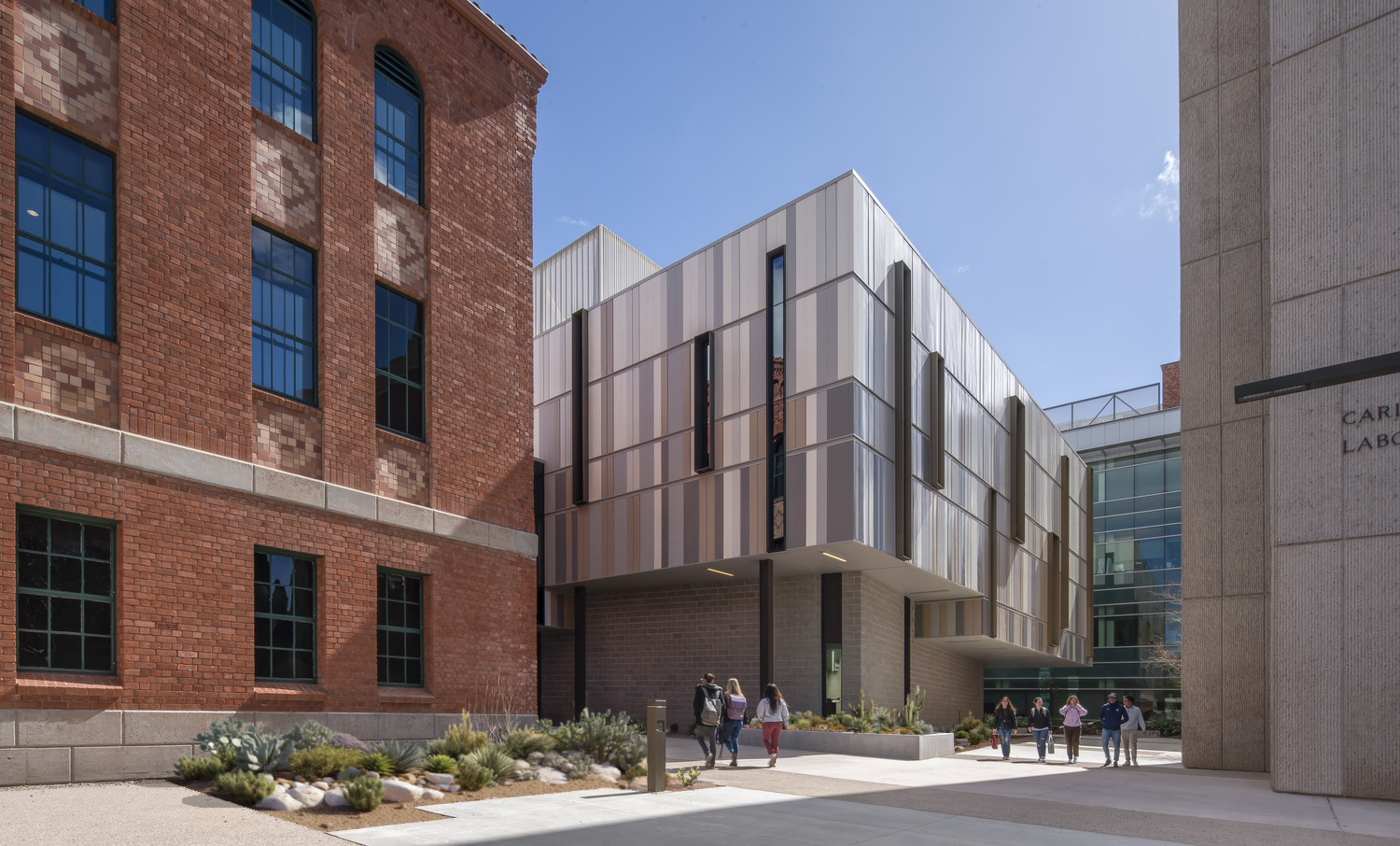
The University of Arizona in Tucson was recently awarded a LEED Silver level certification for the iconic Old Chemistry Building as a demonstration of how new, sustainable design and building strategies can be applied to a historic building to create a 21st century collaborative teaching and learning space.
Green Ideas Building Science Consultants was asked to manage the LEED certification process for the U of A Chemistry Building project by Shepley Bulfinch Architects. We were honored to join the project team so dedicated to sustainable, high-performance design and construction methods…especially considering that LEED certification was not originally targeted for the project due to the historic nature of the building and the challenges that would undoubtedly be encountered with transforming the 85-year-old lab building. Of course, the University of Arizona’s commitment to sustainability and LEED certification, along with the opportunity to work with Shepley-Bulfinch Architects added to Green Ideas’ excitement about joining the project team. The building had lot of issues which needed to be resolved which were not just code related but associated to some of the important LEED aspects like indoor air quality and thermal comfort, and the LEED program was the perfect solution to help to identify these issues and resolve them. According to Pete Rasmussen, Shepley-Bulfinch’s lead Architect for the project, if not located in a historic district the building would have been demolished.
Collaboration among the full team was necessary during the project, as it was designed and constructed during the pandemic. Coordination was accomplished nicely by Shepley Bulfinch and construction partner Sundt Construction of Tucson. This collaborative process enabled the team to stay ahead of pandemic-related procurement and material issues, also helping to accelerate specification of building products which resulted in ten to thirty percent savings of escalation costs of some materials.
Once onboard, Green Ideas began the project by reviewing all project details and developing a viable LEED credit strategy to achieve LEED certification in the most streamlined manner possible. Luckily, the project team had been implementing an integrative design process to the project as directed by Shepley-Bulfinch Architects. Although the LEED Integrative Design Process credit was not targeted the requirements for developing detailed energy and water use budgets were followed, and the project team still focused on design strategies that would deliver the most efficient energy and water savings possible. It was determined that LEED Silver level certification was feasible for the project, so in addition to energy and water savings the team also targeted healthy indoor environment strategies for building occupants by specifying no Red List materials throughout and implementing onsite construction strategies to earn additional LEED credits. LEED points within the following LEED credit categories were achieved:
Location & Transportation Category (12 of 16 possible points achieved)
A remarkable 12 of 16 possible points were earned in this LEED category that awards points for locating a project near local amenities and transportation alternatives. Points were awarded for the Sensitive Land Protection, High Priority Site, Surrounding Density and Diverse Uses, Access to Quality Transit and Reduced Parking Footprint credits. In combination, these LEED credits aim to limit single occupancy vehicle use and to provide easy access to mass transit and local amenities. Since the project is located within the main U of A campus, several of these points were a slam dunk, so most of the points available within this category were achieved. Preferred parking for green vehicles were also provided, along with reduction of the building’s parking footprint. When combined, these strategies helped to create a very accessible building that saves fuel and contributes to a healthy local environment.
Sustainable Sites Category (5 of 10 possible points achieved)
Five of the ten available points in this category were achieved for developing a sustainable site which includes conducting a site assessment prior to construction and providing additional open space adjacent to the building. Two points were earned by mitigating the urban heat island effect by installing permeable hardscape elements and specifying reflective roof surfaces, which also helps with the overall energy efficiency of the building. By keeping all artificial lighting within the project boundary another point was achieved under the Light Pollution Reduction credit.
Water Efficiency Category (1 of 11 possible points achieved)
Since the original building was constructed in three phases (1936, 1948 and 1962) the opportunity for extensive water use reduction was limited, but the project was still able to achieve the potable water reduction goal of 20% from the baseline case and by specifying and installing Water Sense fixtures.
Potable water used for irrigation purposes was reduced by 50%, and permanent water meters that measure total potable water use for the building and site were provided to provide the facility management staff with the capability to monitor the amount of water used for different building operations.
Energy & Atmosphere Category (18 of 33 possible points achieved)
Eighteen of the 33 points were achieved in this category for providing energy cost savings above the ASHRAE 90.1-2010 energy baseline standard by nearly 16%! Quite an accomplishment for a historic building renovation! Energy efficiency was achieved by modifying the existing building envelope, installing new energy efficient windows and specifying efficient mechanical systems. Three points were also earned for installing photovoltaic panels and combined with the University’s purchase of Renewable Energy Certificates (RECs), 100% of the building’s energy needs are covered by green power. All of these energy saving strategies fed into the energy model that Green Ideas performed for the building. The project earned additional points within this category for performing Fundamental and Enhanced Commissioning of the building’s mechanical systems to ensure the owner that all energy and water-using systems were installed, calibrated, and are operating according to the Mechanical Engineer’s specifications. The Enhanced Commissioning credit also included a design phase review of the mechanical system design in order to optimize energy saving design strategies.
Materials & Resources Category (5 of 13 possible points achieved)
The goals of the Materials & Resources category focus on specifying sustainable building products and keeping construction and demolition waste out of landfills. Red List materials were eliminated from the design and more than 50 products that have Environmental Product Declarations (EPDs) were used. Twenty products with Health Product Declarations (HPDs) were also specified and installed, helping the project to earn two points within the Building Product Disclosure and Optimization credits. EPDs and HPDs are essentially a report card for a building product, which gives confidence to specifiers about product environmental attributes, ensuring that the project will have minimal impact on the environment. Sundt Construction, the general contractor for the project, was able to divert 90% of all construction waste materials from the site, which secured the project two additional points towards the LEED Silver level certification.
Indoor Environmental Quality Category (5 of 16 possible points achieved)
Points were awarded in this all-important LEED category for providing additional outside air to the interior portions of the building to improve ventilation and provide enhanced indoor air quality (IAQ). Low-emitting materials that contain very low or zero volatile organic compounds (VOCs) or formaldehyde were specified, earning the maximum of three points in the Low-Emitting Materials credit, also contributing to the building’s excellent IAQ. Sundt Construction implemented an Indoor Air Quality Management Plan during the construction phase to minimize contaminants from being brought into the building during construction. The indoor environmental quality strategies implemented in the building provide the healthiest teaching and learning environment possible for occupants of the building.
Innovation Category (5 of 6 possible points achieved)
The Chemistry Building earned five of the six possible points within the Innovation category. Points were achieved by installing lighting that contains a reduced amount of mercury, and by implementing a Green Building Education Program that uses the building itself as an education tool for occupants and visitors. An additional two Exemplary Performance points were awarded for exceeding the requirements of the Environmental Product Declaration and Low-Emitting Materials credits. The fifth point was earned by having Green Ideas Building Science Consultants as part of the project team under the LEED Accredited Professional credit. These innovative strategies resulted in raising the overall performance level of this historic signature university building.
Regional Priority Category (3 of 4 possible points achieved)
The Regional Priority category offers points for exceeding a U.S. Green Building Council pre-defined threshold for existing credits that are deemed to be very important to the region where the project is located. The Regional Priority credits that were targeted and achieved by the Chemistry Building include High Priority Site (threshold of 1 point), Heat Island Reduction (threshold of 2 points), and Renewable Energy Production (threshold of 3 points).
In the end, this $42 million project delivered with a progressive design-build project delivery method, executed by a highly motivated project team and committed owner resulted in a very successful historic project that was awarded the LEED for New Construction and Major Renovation Silver level certification, achieving 54 total points on February 21, 2024. The Chemistry Building won the Engineering New Record (ENR) Southwest Best Renovation/Restoration Project and AIA Arizona Kemper Goodwin Collaboration Awards. The project is also in the running for several other awards. Visit Green Ideas Building Science Consultants website (www.Egreenideas.com) for more information about the University of Arizona Chemistry Buildings and how Green Ideas can help you to turn your green ideas into reality!
About Green Ideas® Building Science Consultants
Charlie Popeck is President and CEO of Green Ideas, a full-service building science consulting firm offering 3D energy and daylight modeling, building commissioning, and world-class LEED certification services. The firm is designated as a LEED Proven Provider by Green Business Certification Inc. Its clients are building owners, architects, engineers, contractors, real estate developers, facility managers, and corporate entities wishing to establish business advantages through high-performance building practices. With a vision as bold as the results they achieve, Green Ideas is dedicated to transforming the market by promoting building science through a “triple bottom line” approach to business operations.


